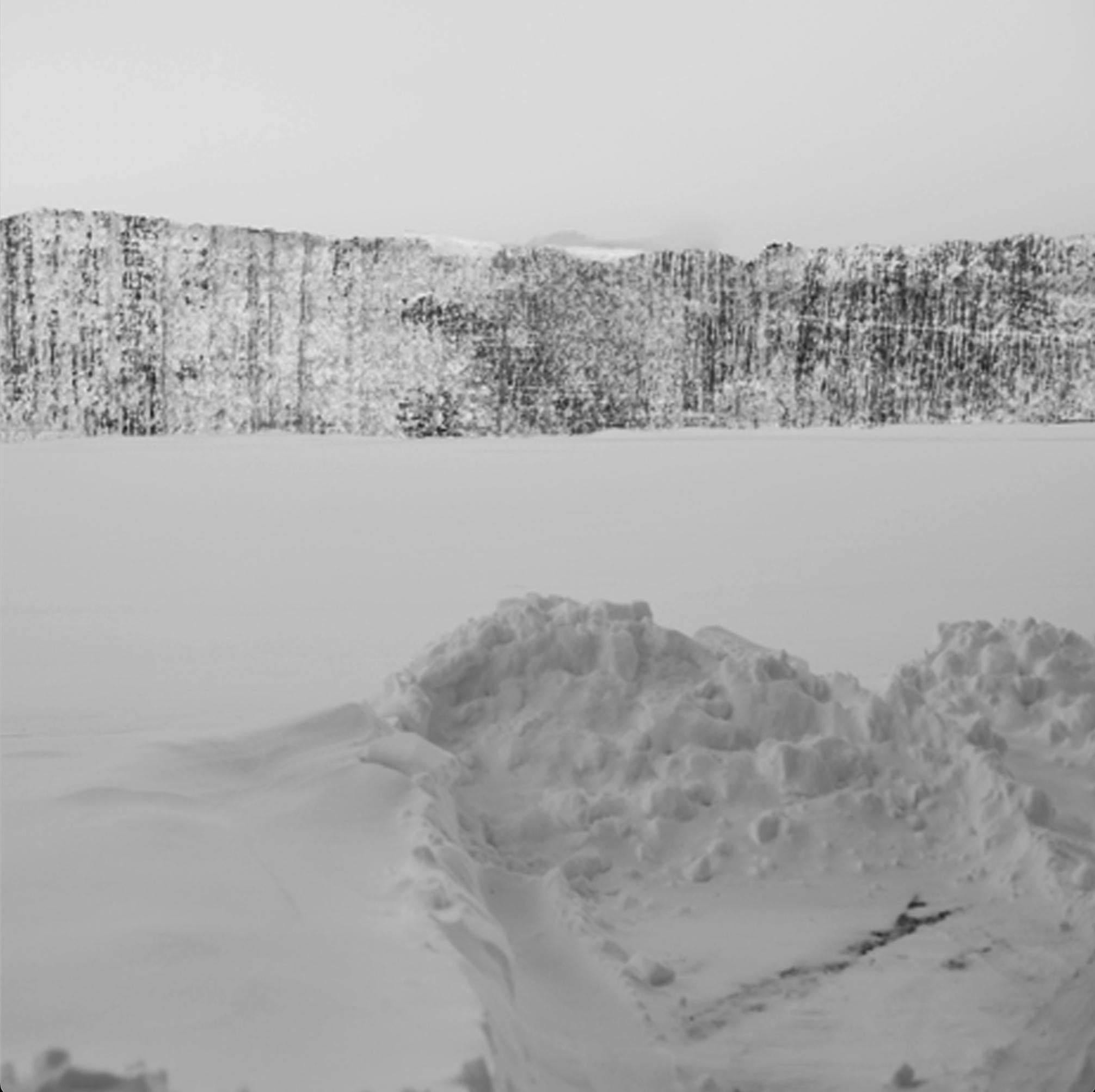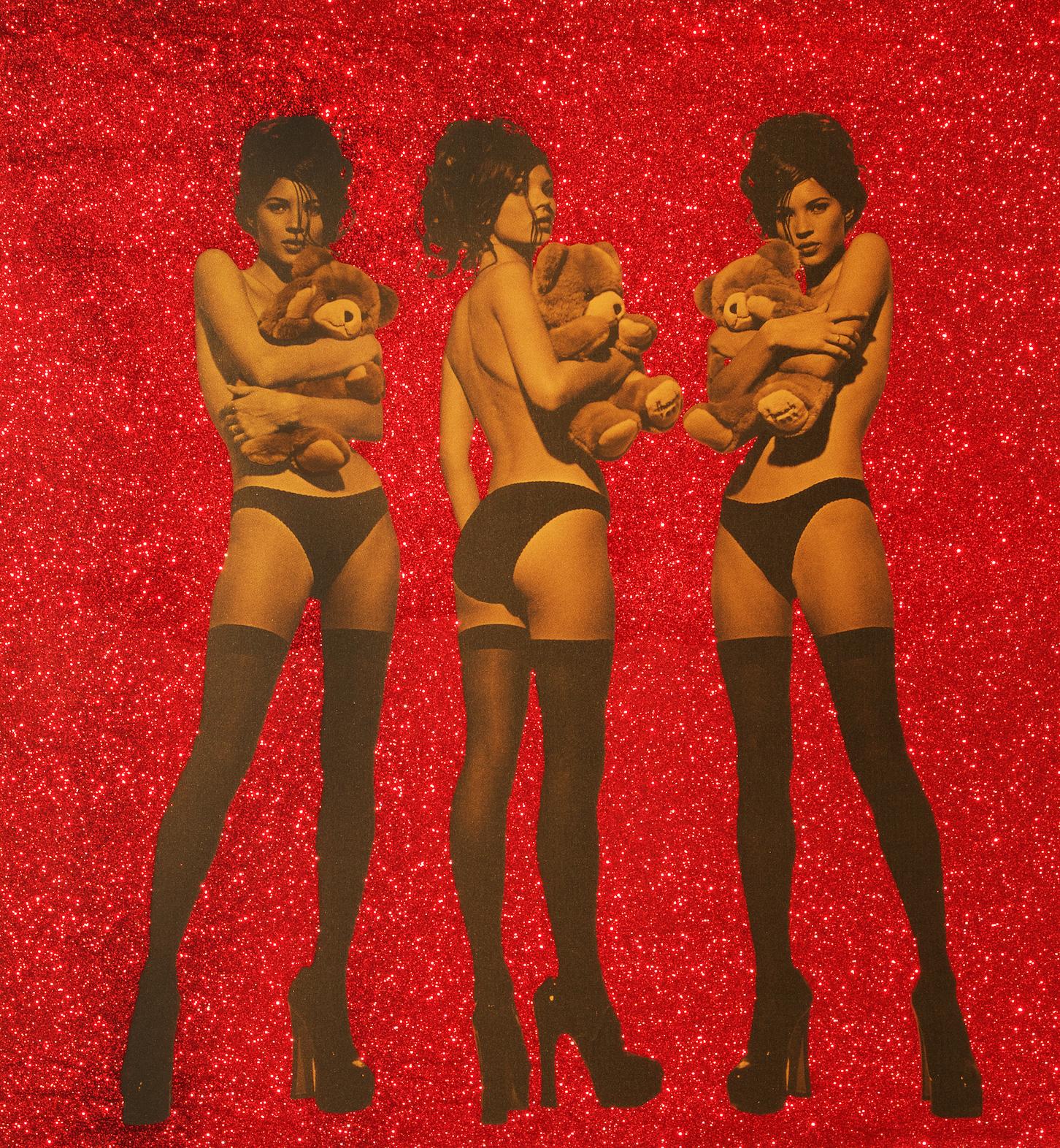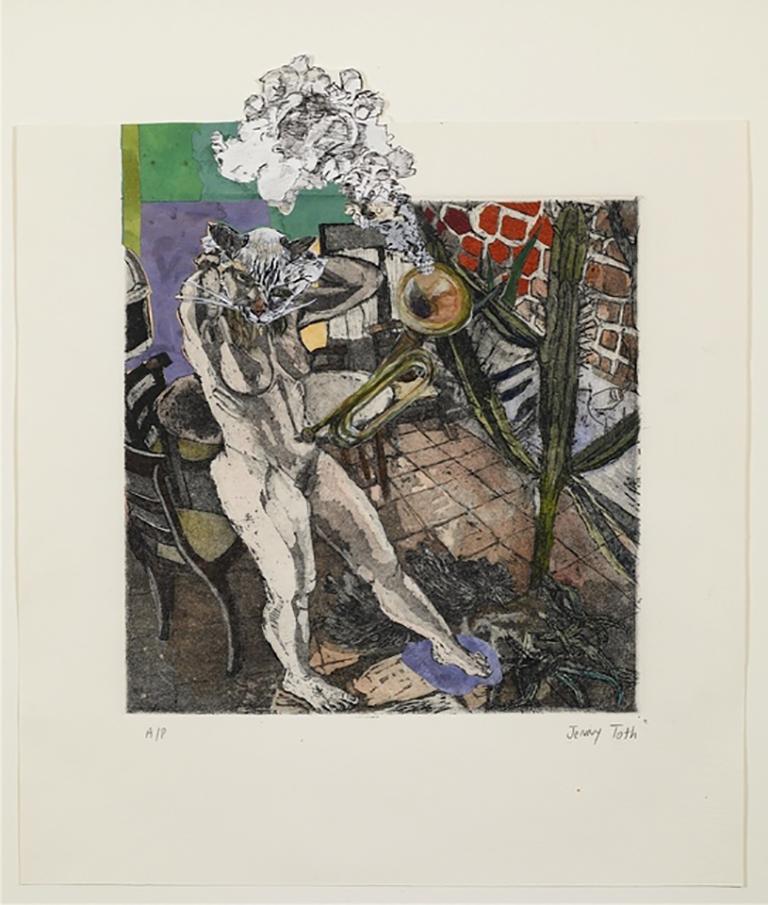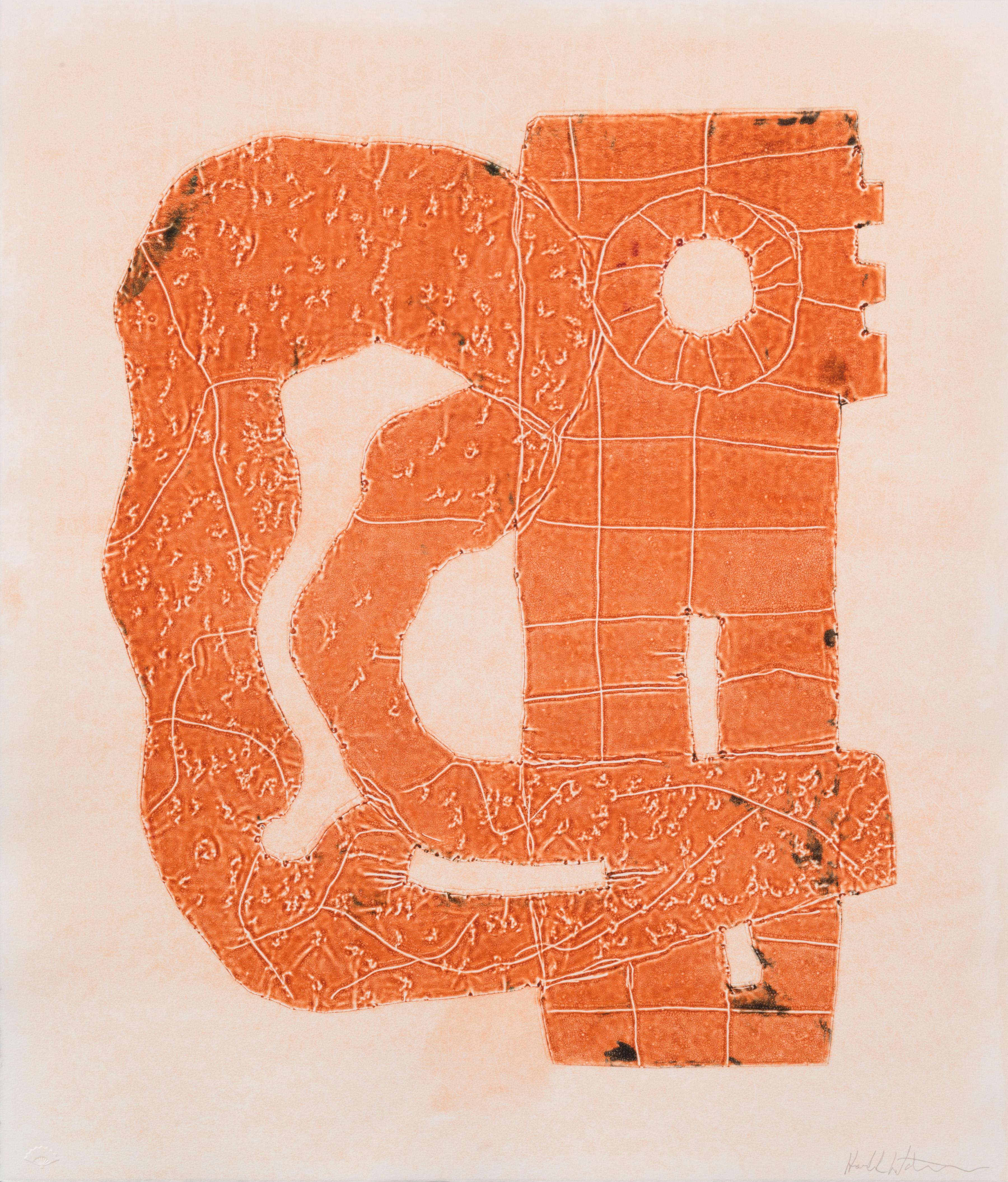Items Similar to Taking Place
Want more images or videos?
Request additional images or videos from the seller
1 of 2
Jessica HoustonTaking Place2022
2022
About the Item
A group of figures heads for icy distant mountains. A familiar enough scene of polar explorers hauling their sledges. Yet somehow this does not quite fit the heroic mold. The ice and sky are tinged a movie musical pale blue and their gear is a bit too colorful for the era of man-hauling. And then there’s the sled, piled high not with boxes of supplies but with a jumbled heap of antiquities: Greek Athenas, bits of a coliseum, a ship’s great wheel. In Jessica Houston’s collage “The Long Haul,” the explorers drag history itself into the great beyond, their backs turned from their absurd load. But we take in the entire scene.
In her suite of works, Over the Edge of the World, Houston uses oil on wood, ink on paper, and collages of found images, many from National Geographic Magazine, to rearrange the evidence – and thus history’s possibilities.
Houston joins visual artists such as Judit Hersko, Katja Aglert, and Isaac Julien who have been inspired by the explorers of the past. Like them, she draws, in part, on the singular tradition of polar exploration narratives as well as fictions such as Ursula Le Guin’s “Sur” (1981), a utopian feminist hoax in which a party of South American women reach the South Pole in 1909, two years before the official arrival of European explorers. Le Guin’s explorers do not feel compelled to leave any written record or physical proof of their presence at the South Pole. If Le Guin’s women might have made it, what other traces have been missed?
Collage can work alongside alternative history: it interprets, interrupts, and rearranges. It questions the completed whole, instead emphasizing composition and relation. Collage suggests it all might be … otherwise. Houston’s collages flaunt their second nature. Yet what they show remains somehow plausible. You want to believe what you’re beginning to see.
In “A life Attuned to Larger Rhythms” Houston grids out rectangles of captured images to overwhelm the eye as the polar environment itself might (whiteout is a paradoxical species of optical overstimulation). Through the strangely ordered confusion of an ice survey grafted atop a chessboard, the mind begins to recognize new connections, emergent shapes: a different future? In “Launching Strategy” a yellow-orange pyramid balances garishly atop a tent. Which came first, the realist tent or the Platonic shape? Can we ever be sure that we’re not already seeing through premade abstractions? Or is it that baggage we’ve been dragging along?
In “Architecture of the Anthropocene” and “Red Blood, Red Earth” Houston reroutes visually symbolic through-lines between women and non-European people and the official history in which they appear dimly or not at all. A full-skirted woman holds onto the tether of a kite that seems to pull her upwards towards a weather balloon floating above an Antarctic base’s radio tower; a row of tropical workers wielding pickaxes folds into the trajectory of a sailor aiming a bow and arrow at an iceberg stained with red. These are not people or images normally associated with polar discovery. But shouldn’t they matter?
“Territory Over Land” strips in a scene from a painted depiction of the tropics, possibly from one of Captain James Cook’s circumnavigations. “Captain Cook’s Legacy” more directly confronts an official portrait of Cook with the torn-in eyes from what can only be described as the explorer’s anonymous dark Other. The hybrid portrait is a kind of contact zone. “Henson and Peary – Past Entanglements” is a cooler, less volatile twin portrait of disputed discoverer of the North Pole Robert Peary and his African-American second in command, Mathew Henson, who was consistently erroneously referred to as Peary’s “manservant.”
Houston re-mystifies polar landscapes that have become through tourism and even the most well-meaning nature documentaries too familiar, too smooth and clean, replete with aesthetically pleasing icebergs and bright icescapes under perfect blue skies. But the poles have 6 months of darkness too. Houston deepens and complicates received images, but without reviving heroic dramas of survival against a blank, enemy ice. The ice in the “Sur” paintings is grimy, oily, swirling with evocations of masted ships swallowed up in dark seas. History is a risk. Survival is not guaranteed.
- Creator:Jessica Houston (1970, American)
- Creation Year:2022
- Dimensions:Height: 10 in (25.4 cm)Width: 14 in (35.56 cm)
- Medium:
- Movement & Style:
- Period:
- Condition:
- Gallery Location:Montreal, CA
- Reference Number:1stDibs: LU47610875872
About the Seller
5.0
Vetted Seller
These experienced sellers undergo a comprehensive evaluation by our team of in-house experts.
Established in 1996
1stDibs seller since 2014
96 sales on 1stDibs
- ShippingRetrieving quote...Ships From: Montreal, Canada
- Return PolicyA return for this item may be initiated within 7 days of delivery.
More From This SellerView All
- Drawing in WaterBy Jessica HoustonLocated in Montreal, QuebecA group of figures heads for icy distant mountains. A familiar enough scene of polar explorers hauling their sledges. Yet somehow this does not quite fit the heroic mold. The ice and sky are tinged a movie musical pale blue and their gear is a bit too colorful for the era of man-hauling. And then there’s the sled, piled high not with boxes of supplies but with a jumbled heap of antiquities: Greek Athenas, bits of a coliseum, a ship’s great wheel. In Jessica Houston’s collage “The Long Haul,” the explorers drag history itself into the great beyond, their backs turned from their absurd load. But we take in the entire scene. In her suite of works, Over the Edge of the World, Houston uses oil on wood, ink on paper, and collages of found images, many from National Geographic Magazine, to rearrange the evidence – and thus history’s possibilities. Houston joins visual artists such as Judit Hersko, Katja Aglert, and Isaac Julien who have been inspired by the explorers of the past. Like them, she draws, in part, on the singular tradition of polar exploration narratives as well as fictions such as Ursula Le Guin’s “Sur” (1981), a utopian feminist hoax in which a party of South American women reach the South Pole in 1909, two years before the official arrival of European explorers. Le Guin’s explorers do not feel compelled to leave any written record or physical proof of their presence at the South Pole. If Le Guin’s women might have made it, what other traces have been missed? Collage can work alongside alternative history: it interprets, interrupts, and rearranges. It questions the completed whole, instead emphasizing composition and relation. Collage suggests it all might be … otherwise. Houston’s collages flaunt their second nature. Yet what they show remains somehow plausible. You want to believe what you’re beginning to see. In “A life Attuned to Larger Rhythms” Houston grids out rectangles of captured images to overwhelm the eye as the polar environment itself might (whiteout is a paradoxical species of optical overstimulation). Through the strangely ordered confusion of an ice survey grafted atop a chessboard, the mind begins to recognize new connections, emergent shapes: a different future? In “Launching Strategy” a yellow-orange pyramid balances garishly atop a tent. Which came first, the realist tent or the Platonic shape? Can we ever be sure that we’re not already seeing through premade abstractions? Or is it that baggage we’ve been dragging along? In “Architecture of the Anthropocene” and “Red Blood, Red Earth” Houston reroutes visually symbolic through-lines between women and non-European people and the official history in which they appear dimly or not at all. A full-skirted woman holds onto the tether of a kite that seems to pull her upwards towards a weather balloon floating above an Antarctic base’s radio tower; a row of tropical workers wielding pickaxes folds into the trajectory of a sailor aiming a bow and arrow at an iceberg stained with red. These are not people or images normally associated with polar discovery. But shouldn’t they matter? “Territory Over Land” strips in a scene from a painted depiction of the tropics, possibly from one of Captain James Cook’s circumnavigations. “Captain Cook’s Legacy” more directly confronts an official portrait of Cook with the torn-in eyes from what can only be described as the explorer’s anonymous dark Other. The hybrid portrait is a kind of contact zone. “Henson and Peary – Past Entanglements” is a cooler, less volatile twin portrait of disputed discoverer of the North Pole Robert Peary...Category
2010s Contemporary Mixed Media
MaterialsInk, Archival Paper
- FootprintsBy Jessica HoustonLocated in Montreal, QuebecA group of figures heads for icy distant mountains. A familiar enough scene of polar explorers hauling their sledges. Yet somehow this does not quite fit the heroic mold. The ice and...Category
2010s Contemporary Mixed Media
MaterialsInk, Archival Paper
- The Fatigue of the ConquestBy Jessica HoustonLocated in Montreal, QuebecA group of figures heads for icy distant mountains. A familiar enough scene of polar explorers hauling their sledges. Yet somehow this does not quite fit the heroic mold. The ice and sky are tinged a movie musical pale blue and their gear is a bit too colorful for the era of man-hauling. And then there’s the sled, piled high not with boxes of supplies but with a jumbled heap of antiquities: Greek Athenas, bits of a coliseum, a ship’s great wheel. In Jessica Houston’s collage “The Long Haul,” the explorers drag history itself into the great beyond, their backs turned from their absurd load. But we take in the entire scene. In her suite of works, Over the Edge of the World, Houston uses oil on wood, ink on paper, and collages of found images, many from National Geographic Magazine, to rearrange the evidence – and thus history’s possibilities. Houston joins visual artists such as Judit Hersko, Katja Aglert, and Isaac Julien who have been inspired by the explorers of the past. Like them, she draws, in part, on the singular tradition of polar exploration narratives as well as fictions such as Ursula Le Guin’s “Sur” (1981), a utopian feminist hoax in which a party of South American women reach the South Pole in 1909, two years before the official arrival of European explorers. Le Guin’s explorers do not feel compelled to leave any written record or physical proof of their presence at the South Pole. If Le Guin’s women might have made it, what other traces have been missed? Collage can work alongside alternative history: it interprets, interrupts, and rearranges. It questions the completed whole, instead emphasizing composition and relation. Collage suggests it all might be … otherwise. Houston’s collages flaunt their second nature. Yet what they show remains somehow plausible. You want to believe what you’re beginning to see. In “A life Attuned to Larger Rhythms” Houston grids out rectangles of captured images to overwhelm the eye as the polar environment itself might (whiteout is a paradoxical species of optical overstimulation). Through the strangely ordered confusion of an ice survey grafted atop a chessboard, the mind begins to recognize new connections, emergent shapes: a different future? In “Launching Strategy” a yellow-orange pyramid balances garishly atop a tent. Which came first, the realist tent or the Platonic shape? Can we ever be sure that we’re not already seeing through premade abstractions? Or is it that baggage we’ve been dragging along? In “Architecture of the Anthropocene” and “Red Blood, Red Earth” Houston reroutes visually symbolic through-lines between women and non-European people and the official history in which they appear dimly or not at all. A full-skirted woman holds onto the tether of a kite that seems to pull her upwards towards a weather balloon floating above an Antarctic base’s radio tower; a row of tropical workers wielding pickaxes folds into the trajectory of a sailor aiming a bow and arrow at an iceberg stained with red. These are not people or images normally associated with polar discovery. But shouldn’t they matter? “Territory Over Land” strips in a scene from a painted depiction of the tropics, possibly from one of Captain James Cook’s circumnavigations. “Captain Cook’s Legacy” more directly confronts an official portrait of Cook with the torn-in eyes from what can only be described as the explorer’s anonymous dark Other. The hybrid portrait is a kind of contact zone. “Henson and Peary – Past Entanglements” is a cooler, less volatile twin portrait of disputed discoverer of the North Pole Robert Peary...Category
2010s Contemporary Mixed Media
MaterialsInk, Archival Paper
- 72.89ºS, 8.15ºW; 75º @ 21 km/h; 35.0ºC 22/09/15 18:00 LocalBy Colleen WolstenholmeLocated in Montreal, QuebecBy Sophie Lynch In Hyperobjects, Nova Scotia-based artist Colleen Wolstenholme presents works that developed from her earlier drawings of brain cell patterns and her interest in t...Category
2010s Contemporary Abstract Drawings and Watercolors
MaterialsInk, Archival Paper
- 74.09ºS, 179.90ºW; 255º@29 km/h; 21, 1ºC 06/10/15 09:00 LocalBy Colleen WolstenholmeLocated in Montreal, QuebecBy Sophie Lynch In Hyperobjects, Nova Scotia-based artist Colleen Wolstenholme presents works that developed from her earlier drawings of brain cell patterns and her interest in t...Category
21st Century and Contemporary Contemporary Abstract Drawings and Waterco...
MaterialsInk, Archival Paper
- Human Tides (Conflicts II) #29By Renato Garza CerveraLocated in Montreal, QuebecWhen does a line on a page become figurative? The series of drawings by Mexican artist Renato Garza Cervera entitled Mareas Humanas (Conflictos II) / Human Tides (Conflicts II) satis...Category
2010s Contemporary Figurative Drawings and Watercolors
MaterialsIndia Ink, Archival Paper
You May Also Like
- The Glory of a DreamBy On HansenLocated in PREMIÀ DE MAR, ES"The Glory of a Dream" is one of the 14 pieces that make up "Spectrum's End," the latest artwork by artist On Hansen. "The Glory of a Dream" consists of 10 pigment print editions on ...Category
2010s Contemporary Mixed Media
MaterialsOil Pastel, Archival Ink, Archival Paper
- Candlewood Lake, CT. Winter 2011-2016By Iliana OrtegaLocated in New York, NYThis is a unique artwork. Made of an Archival inkjet print then scratched on top of the surface creating a second effect. This is a unique artwork. Made of an Archival inkjet print...Category
2010s Contemporary Landscape Photography
MaterialsArchival Ink, Archival Paper, Black and White, Archival Pigment
- "Kate Moss Nr. 8" Photography 58 × 53 1/2 in Edition 1/1 by Kate GarnerBy Kate GarnerLocated in Culver City, CA"Kate Moss Nr. 8" Photography 58 × 53 1/2 in Edition 1/1 by Kate Garner Signed on the back. High Quality Print on Hahnemuhle paper using archival ink with red full diamond dust bac...Category
21st Century and Contemporary Contemporary Nude Photography
MaterialsArchival Ink, Glitter, Archival Paper, Stretcher Bars
- Shutting Out Self Doubt, hand tinted etching of cat woman nude, music instrumentBy Jenny TothLocated in Brooklyn, NYAquatint and watercolor collage by Jenny Toth, mixed media artist, professor, graduate of Yale School of ArtCategory
2010s Contemporary Mixed Media
MaterialsWatercolor, Aquatint, Archival Ink, Archival Paper, Etching
- "OWL ROCK", print, hand-tooled aluminum intaglio, abstract contemporary, etchingBy Harold WortsmanLocated in Toronto, OntarioOWL ROCK is a hand-tooled aluminum intaglio print on Rives BFK 250g paper with deckle edge. It is currently unframed. Like Wortsman's own sculptures, the abstract components here mix the organic with roughly-hewn geometric forms. Note the dialogue between the colors umber, green and white, with the 3 perforations tying it all in – it is characteristic of Wortsman's practice. Warm, contemporary, uniquely crafted, yet speaks to ancient, tribal traditions of art-making that cross cultures and histories. Highly attuned to the indigenous art of Africa, the Middle East, India and Asia, his forms are organic and geometric abstracts with masculine and feminine attributes that resonate together as a pleasing enigma. They make sense immediately, yet never give up all their secrets. OWL ROCK was exhibited at Tabla Rasa Gallery, Brooklyn, New York in 2013. And at Made In Brooklyn, Hanson Gallery, Honesdale, Pennsylvania, 2015. From Harold Wortsman – "I was introduced to printmaking in the 1990s by legendary printmaker, the late Sheila Marbain. Printer to the masters of Pop Art, like Oldenberg, Lichtenstein and Warhol, she tired of conventional silkscreen and developed her own silkscreen monotype technique. Several years of work with Marbain led to etching and hand-tooled aluminum intaglio with the great printer Sheila Goloborotko. I currently work with master printer Kathy Caraccio. While working together on a difficult project, Caraccio exclaimed: “This is not a print; it’s a painting.” Printmaking is now an integral part of the work I do." From Jonathan Goodman, Art Critic – "There are certain kinds of art that endure beyond the novel effect, demonstrating an awareness of time-honored methods and even historically potent imagistic biases, and Wortsman's work belongs to this ongoing vision." – Fronterra D, October 2016. Harold Wortsman is a sculptor and printmaker based in Brooklyn, NY. He “creates forms that bring to mind archaic cult objects and exude a quiet concentrated strength.” (Argauer Zeitung, Switzerland). His work, an edgy mix of freedom and clarity, can be found in public and private collections in the US, including The Library of Congress, Yale University, The New York Public Library Print Collection, The New York Historical Society, Smith College, Indiana University’s Lilly Library, Brandeis University, The Newark Public Library Special Collections Division, and the Jane Voorhees Zimmerli Art Museum Print Archive. Also in private and public collections in Europe, including the Municipal Collection of the City of Brugg, Switzerland. Harold studied at the New York Studio School of Drawing, Painting and Sculpture, with sculptor George Spaventa...Category
21st Century and Contemporary Contemporary Abstract Prints
MaterialsPrinter's Ink, Etching, Archival Paper, Intaglio
- "PROPOSITION", hand-tooled aluminum intaglio print, abstract, monotype, framedBy Harold WortsmanLocated in Toronto, OntarioPROPOSITION is a hand-tooled aluminum intaglio print on Rives BFK 250g paper with deckle edge. It is a framed monotype in white matte wood with spacers under glass to maintain the de...Category
21st Century and Contemporary Contemporary Abstract Prints
MaterialsWood, Printer's Ink, Archival Paper, Etching, Intaglio, Glass





